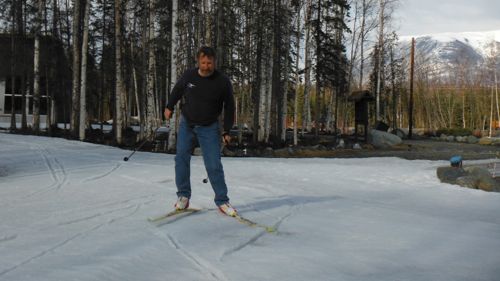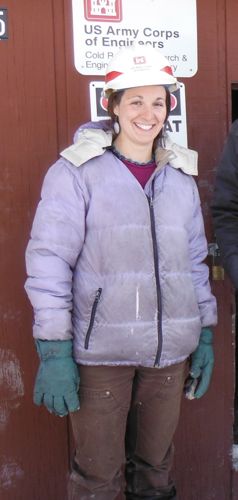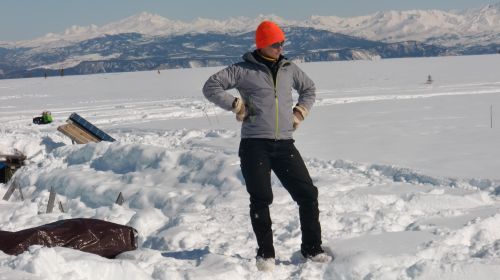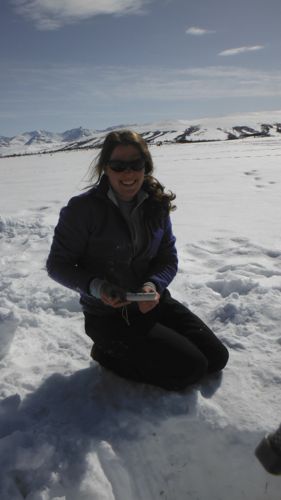The Expedition came to a close on Friday May 3, 2013. I decided to travel through Chugiak, AK to stop and visit my mom over the weekend prior to going back to Vermont.
 Skiing on the trails at Chugiak High School the evening before I left Alaska.
Skiing on the trails at Chugiak High School the evening before I left Alaska.
 View of Mount Foraker, Mount Hunter (where PolarTREC teacher Ken Williams is currently located) and Mount McKinley from Bald Mtn. in Chugiak, AK.
View of Mount Foraker, Mount Hunter (where PolarTREC teacher Ken Williams is currently located) and Mount McKinley from Bald Mtn. in Chugiak, AK.
Reflections:
 CiPEHR etched into the sandy bank along the north side of Healy Creek at Isabelli Coal Mine.
CiPEHR etched into the sandy bank along the north side of Healy Creek at Isabelli Coal Mine.
During this past 6 weeks I’ve had many experiences. During the week of polarTREC orientation I had the opportunity to experience one of the most professional, organized and interesting educational conferences I have attended. I met many energetic dedicated teachers from around the country. These people with whom I have similar interests and are motivated to improve the way science is communicated.
The successive 5 weeks spent in Healy at the University of Florida Research Site were every bit as interesting and challenging as I had anticipated. I gained insights into scientific research that I will take with me back to my classroom. Thanks to Elizabeth Webb (researcher), John Krapek (field technician) and Kirsten K. Coe (site manager) I became part of a research team that is looking at important questions basic to climate change.
 Elizabeth Webb at the Permafrost Tunnel north of Fairbanks, AK.
Elizabeth Webb at the Permafrost Tunnel north of Fairbanks, AK.
 John Krapek standing shovel ready at CiPEHR.
John Krapek standing shovel ready at CiPEHR.
 Kirsten K. Coe, Site Manager at CiPEHR, observing snowblowing operations.
Kirsten K. Coe, Site Manager at CiPEHR, observing snowblowing operations.
A couple of the many lessons I learned in the past 5 weeks:
Logistics and teamwork are very important to the collection of good scientific data in the polar environment. Development of these skills is often overlooked in the science classroom.
Data collection in the polar environment is not easy. The researchers ability to troubleshoot equipment failures and persistence in fixing them can play an enormous role in the ultimate success of the experiment. A researcher must be able to withstand cold temperatures, solitude, forgo many of life’s comforts usually taken for granted and finally expect the unexpected.
 John Krapek troubleshooting the Li-COR and data collection apparatus at the Off-plot Site on CIPEHR.
John Krapek troubleshooting the Li-COR and data collection apparatus at the Off-plot Site on CIPEHR.
 Elizabeth Webb and John Krapek on a cold day conducting data collection at the On-plot site on CiPEHR.
Elizabeth Webb and John Krapek on a cold day conducting data collection at the On-plot site on CiPEHR.
In conclusion…I plan to travel back to the CiPEHR Site this August to look at the summer set-up for data collection. Look for a journal update at that time. A big Thank You to the folks at PolarTREC. PolarTREC is a truly unique organization in providing teachers with research experience.
Here are a few of my favorite photos from the past 6 weeks.
 John Krapek at the On-plot site on CiPEHR with an avalanche probe used for measuring snow depth.
John Krapek at the On-plot site on CiPEHR with an avalanche probe used for measuring snow depth.
 Catherine Johnston modeling the snow density collection tube from the Off-plot sites at CiPEHR.
Catherine Johnston modeling the snow density collection tube from the Off-plot sites at CiPEHR.
 Elizabeth Webb, Ted Schuur and myself at the end of shovel week at CiPEHR.
Elizabeth Webb, Ted Schuur and myself at the end of shovel week at CiPEHR.
 Jade and her puppies comfortable in their house in the dog yard at the field site cabin. The puppies are about 3 weeks old.
Jade and her puppies comfortable in their house in the dog yard at the field site cabin. The puppies are about 3 weeks old.
 Early morning sunrise on the Alaska Range from Menkent Rd. Healy, AK.
Early morning sunrise on the Alaska Range from Menkent Rd. Healy, AK.
Here is one item I won’t miss from the expedition.
 The outhouse at the field site cabin near Healy, AK.
The outhouse at the field site cabin near Healy, AK.
Here’s two mystery photos…
 What is it?
What is it?
 What happened here?
What happened here?
And finally...back in Westford, Vermont.
 Here I am with Beth, in Vermont, after the PolarTREC Expedition.
Here I am with Beth, in Vermont, after the PolarTREC Expedition.
